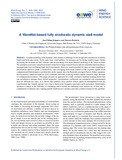Citation link:
http://dx.doi.org/10.25819/ubsi/10188Files in This Item:
| File | Description | Size | Format | |
|---|---|---|---|---|
| A_WaveNet-based_fully_stochastic_dynamic_stall_model.pdf | 8.44 MB | Adobe PDF |  View/Open |
| Dokument Type: | Article | metadata.dc.title: | A WaveNet-based fully stochastic dynamic stall model | Authors: | Küppers, Jan-Philipp Reinicke, Prof. Dr.-Ing. Tamara |
Institute: | Department Maschinenbau | Free keywords: | Stochastisches dynamisches Strömungsabrissmodell, Stochastic dynamic stall model | Dewey Decimal Classification: | 620 Ingenieurwissenschaften und zugeordnete Tätigkeiten | GHBS-Clases: | WDK WDA |
Issue Date: | 2022 | Publish Date: | 2022 | Source: | Wind Energy Science ; 7 (5), S. 1889–1903. - DOI: https://doi.org/10.5194/wes-7-1889-2022 | Abstract: | Accurate modeling of the dynamic stall remains a challenge for the design and construction of turbine blades and helicopter rotors. At the same time, wind turbines, for instance, are becoming steadily larger, further increasing the demands on their structure and necessitating even more detailed modeling of the forces at hand. The primarily used (semi-)empirical models today have a long research history and are invariably based on phase-averaged data from oscillating blade pitch experiments. However, much potential for more accurate modeling of uncertainties and force peaks is wasted here, since averaging blurs many features of the response signals. Even computational fluid dynamics can help little in this regard, since the Reynolds-averaged Navier–Stokes equations used in practice cannot account for cycle variations, and scale-resolving models require extremely large amounts of computational resources. This paper presents an approach for a fully stochastic machine learning model that can nevertheless simulate these critical properties. Aerodynamic coefficients are compared with experimental data for different test cases. It is shown that synthetic force profiles which cannot be distinguished from the experimental data visually and are very close to them in the frequency spectrum can be generated. Additionally, attention is drawn to the difficulty of evaluating such a model, as traditional error metrics are of little use. A combination of dynamic time warping and the Earth mover's distance provides a robust solution for this problem. |
Description: | Finanziert aus dem Open-Access-Publikationsfonds der Universität Siegen für Zeitschriftenartikel |
DOI: | http://dx.doi.org/10.25819/ubsi/10188 | URN: | urn:nbn:de:hbz:467-22775 | URI: | https://dspace.ub.uni-siegen.de/handle/ubsi/2277 |
| Appears in Collections: | Geförderte Open-Access-Publikationen |
This item is protected by original copyright |
Page view(s)
290
checked on Nov 28, 2024
Download(s)
65
checked on Nov 28, 2024
Google ScholarTM
Check
Altmetric
Items in DSpace are protected by copyright, with all rights reserved, unless otherwise indicated.

